What buried cities in the United States in the 19th century?
What buried cities in the United States in the 19th century?
Many people have seen the buried old buildings, but the following questions are not quite clear —
The first question is how much were the buildings filled in, to what maximum level?
The second question — if the buildings in the cities were filled in, at least one and a half to two meters, then how and how they were dug up? After all, these are huge volumes of soil.
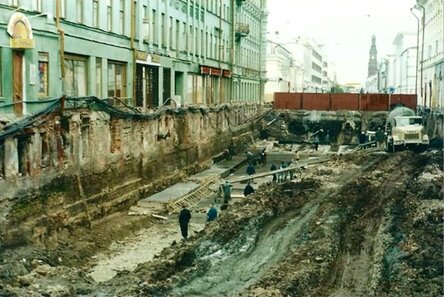
If in Europe buildings were buried as we all think on one floor, then in the United States buildings were buried a little more.
Consider the example of two American cities: Seattle and Kansas.
Both cities are interesting to us because they had buried houses.
Seattle is located on the coast at an altitude of only 42 meters above sea level.
And Kansas is located inland at an altitude of 269 meters above sea level.
let's take a look at the vintage photos:
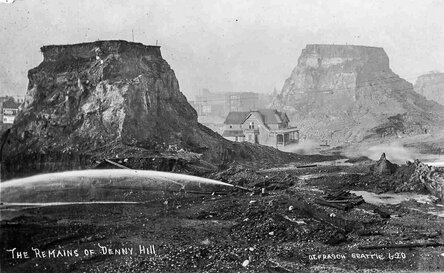
These are photos from Seattle and we see just surreal views. What's going on here anyway?
We see colossal piles of soil, the flat tops of which indicate that this was previously the earth's surface.
Here's what I found on the Internet:
In the early 20th century, Seattle, Washington was rapidly becoming a major center of trade in the Pacific Northwest.
Located on a narrow hilly isthmus, the city had to grow in an organized manner.
After a fire that destroyed much of the city center, city engineer Thomson took the opportunity to lead a large-scale effort to tame the terrain around the city and prepare it for a century of growth.
Canals were dug, rivers were diverted from the side, and mountains were moved.
In particular, the glacial hills and ridges that separated the neighborhood from the downtown waterfront were considered a major obstacle to travel and trade and became a major target for removal.
From the 1890s to the 1920s, more than 38 million cubic meters of land were cleared using axes, water cannons, steam excavators, and conveyor belts. Most of the displaced land was used to fill the tidal flats on the waterfront.
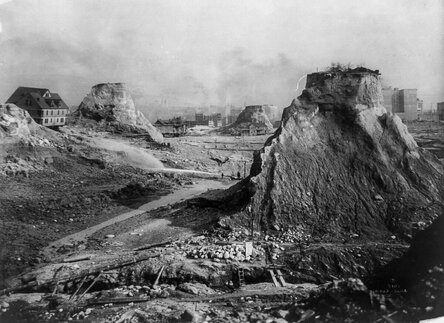
Very interesting phrase — glacial hills, in the original written Glacial hills, we will discuss this point later.
Consider the photo: there are houses at the bottom, apparently wooden.
It is quite difficult to understand these houses have always stood at this level, that is, were they built like this, or were these houses dug up?
For excavated houses, they look very intact, they have a roof, roofing material in place. There was an idea that the soil from under the house was gradually removed and the house thus gradually sank to the required level. If the house is wooden, then this is possible.
For example, in this photo, you can see that the house is slightly tilted relative to the horizon, and on the right, you can see people who are eroding the ground under the house with a powerful jet of water.
Here's what we found on this score:
Many of the houses that were to be removed from the hill did not need to be demolished. They were simply blown up by the flow of water, and when they fell into the pit, they were set on fire.
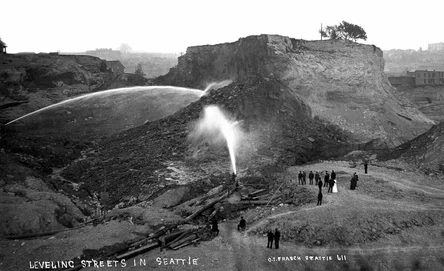
In our collection, there will be several photos in which people water the earth with a powerful stream of water. If in the previous photo they may have washed the ground under the house, then what exactly is happening in these photos is unclear. This photo is captioned Leveling streets in Seattle
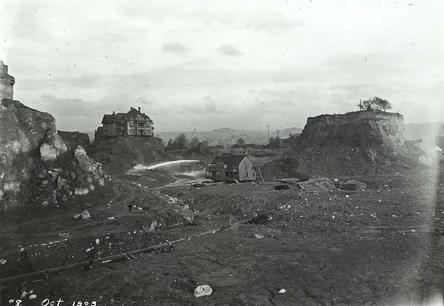
Here is another photo where you can clearly see the pipeline and watering the land with water.

In this panoramic photo, the ground is being watered and the house stands slightly tilted in an extraordinary place among the blurred ground. Why water the earth with powerful jets of water — share your thoughts in the comments.
Someone will say that they pour water so that there is no dust. But where does this dust come from-if no work is being done at the moment?
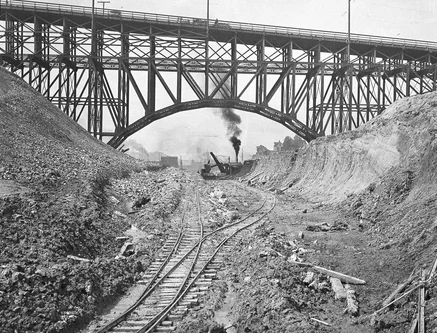
In other photos opposite, excavators are excavating, but the ground is not watered with water.
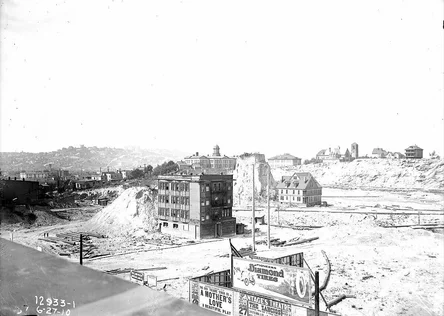
In this photo, in the middle, we see a large capital stone four-story building and a massive pile of dirt next to it. The building is partially covered with soil on the left. You can consider several versions: this building was built, and later covered with soil, or the building was built next to this massive pile of soil, which is hard to believe.
The house further and to the right is also adjacent to a huge pile of soil, and this house also has a lot of questions from the how, why, and why series.
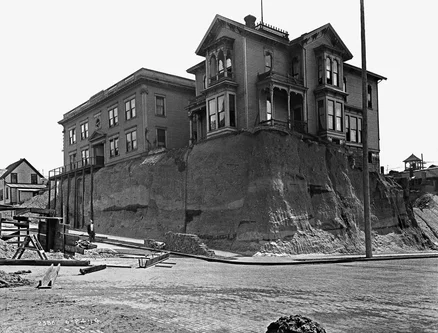
Let's take a look at some more photos:
In this photo, we see two buildings as if on a hill, the height of the hill is almost equal to the height of the building. Where the ground is cleared, the pavement is visible, it is not entirely clear whether the pavement was dug up or decided to layout the pavement without waiting for the end of all earthworks.
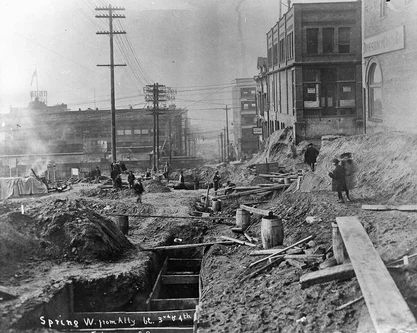
This photo shows that the building with arches was heavily filled in on one side.
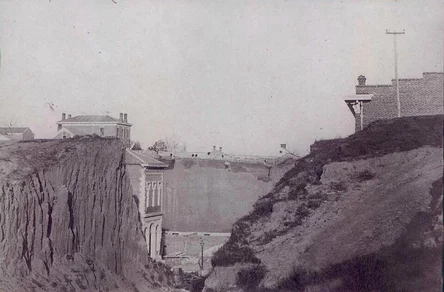
Here are photos from Kansas, where we see a building covered with soil up to the roof! Someone will say-Ko-Ko-Ko is just such a perspective, it's just in front of the building hill
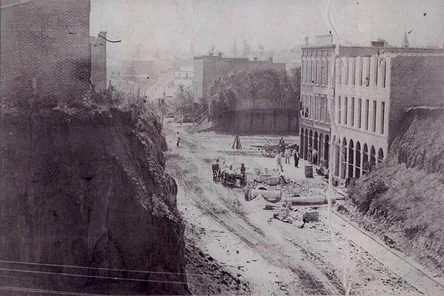
okay, let's look at the following photo, which shows that the stone building is covered with soil on the side to the height of two high floors.
This is about 4 growth of a person, a total of 7 meters.
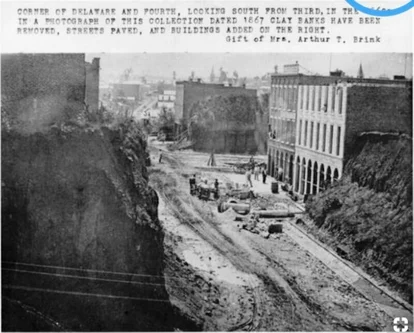
This is the same photo with the caption:
The corner of Delaware and fourth street faces South with third in the center of town.
The photo of this collection is dated 1867.
The clay jars were removed, the streets were paved and buildings were added to the right.
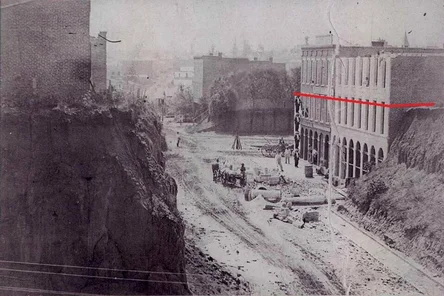
The height of falling asleep of buildings easily reached 7 meters and this is a huge amount of soil.
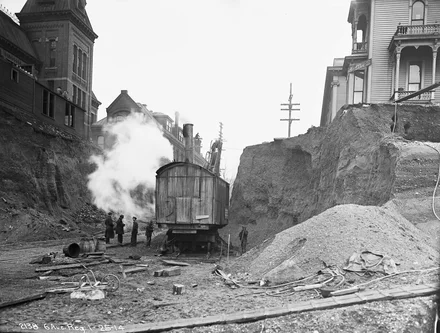
If the city authorities decided to remove this volume of soil, it was a very difficult task.
Heavy machinery, such as excavators, was used to clear the cities.
Excavators moved on rails, and here for example the excavator in the middle of the street on a segment of a rail track with sleepers.
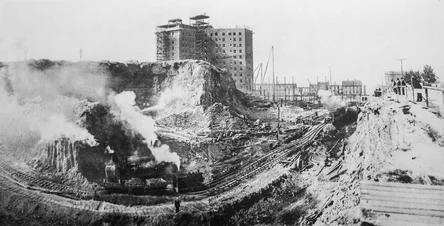
And here is a photo where the excavator loads the soil into the train cars.
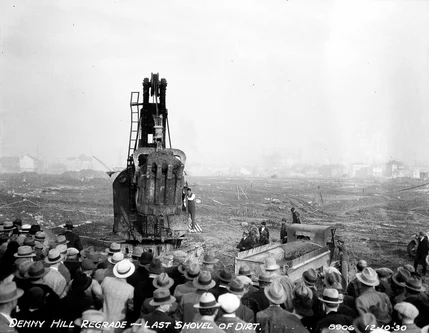
In this photo, a crowd gathered to witness the last bucket of dirt and the completion of the second redevelopment of the city.
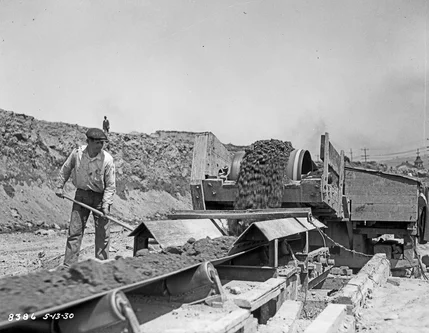
Railway transport was used to remove the soil. The rails were laid right on the streets of the city.
In addition to heavy equipment, manual labor and carts were used.
Long conveyor belts were also used, along which the soil was transported over long distances.
Here, for example, is a closed conveyor belt leading the ground to the Harbor.
Conclusions
In this article, we showed you only the United States, but believe me, all over the world, you can easily find buildings buried in the ground of one type of architecture. Many buildings run not only along roads, and it is simply impossible to explain this by shrinkage or laying of the road surface. I'm not talking about the fact that the Colosseum in Italy was also completely buried and unearthed not so long ago. What's it? Traces of a global catastrophe or war? What has buried cities all over the world? Try to think about it, and also look at the buildings in your city. If you are interested, we will record you a video clip with even more shocking materials
About author:
Serg Toporkov Ufologist, Ph.D., blogger, I go on my own expeditions for UFOs. I use scientific methods to investigate the UAP phenomenon. Write to me |
Related tags:
buried cities buried buildings conspiracy conspiracy theories 19th century USA Europe United StatesRandom UFO or conspiracy article
Aliens attack the ISS. Russian cosmonaut finds alien life
 Russian scientists have proved the existence of alien life. However, this is not a humanoid or any advanced form, but a biological variety.
Russian scientists have proved the existence of alien life. However, this is not a humanoid or any advanced form, but a biological variety.
